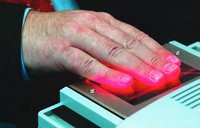 from business online: A global database to monitor travellers entering and leaving the European Union and the United States is being tested in Britain and America. The project for the US Department of Homeland Security would create a global identity database using biometric identification such as digital fingerprinting. People involved in the trial say it could be extended to include countries such as Canada.
from business online: A global database to monitor travellers entering and leaving the European Union and the United States is being tested in Britain and America. The project for the US Department of Homeland Security would create a global identity database using biometric identification such as digital fingerprinting. People involved in the trial say it could be extended to include countries such as Canada.Troy Potter, biometrics manager for the US Department of Homeland Security’s border control programme, told The Business: “Early stage discussions about what we should be doing to make biometric information sharing happen are currently taking place between like-minded countries such as Britain and other European Union members.”
The task of checking the biometric data of hundreds of millions of European and American citizens is enormous. The trials will establish whether it is technically feasible to build such a network.
An industry source said governments in Britain and France were likely to demand a share of the huge hardware and software contracts were the project to go ahead. Matt Howell, vice president for justice, security and defence at Capgemini, said: “The project would be very significant in financial terms. Biometric technology is itself so sophisticated, it will inevitably drive up costs. Added to this is the extra cost associated with network security, which would be of paramount importance.”
Howell added: “The project is entirely feasible in technical terms. The real stumbling blocks are governance and civil liberties issues, which are taken extremely seriously by the European Union.” It has not been determined which forms of biometric identification would be best suited to border control. Most systems use an easily identifiable part of the body, such as a fingertip or eye. But these methods do not work when the subject has an injury. A less intrusive and speedier form of identification could use digital cameras to match an instant shot of a traveller to the global database.
“Biometric identification refers to digital fingerprinting and also potentially to other techniques such as iris recognition and digital photos,” explained Potter.

No comments:
Post a Comment